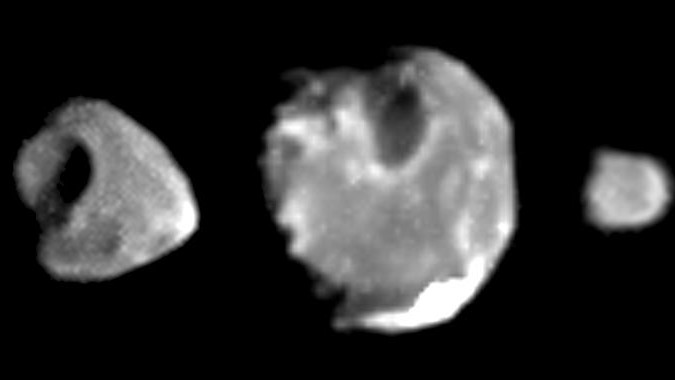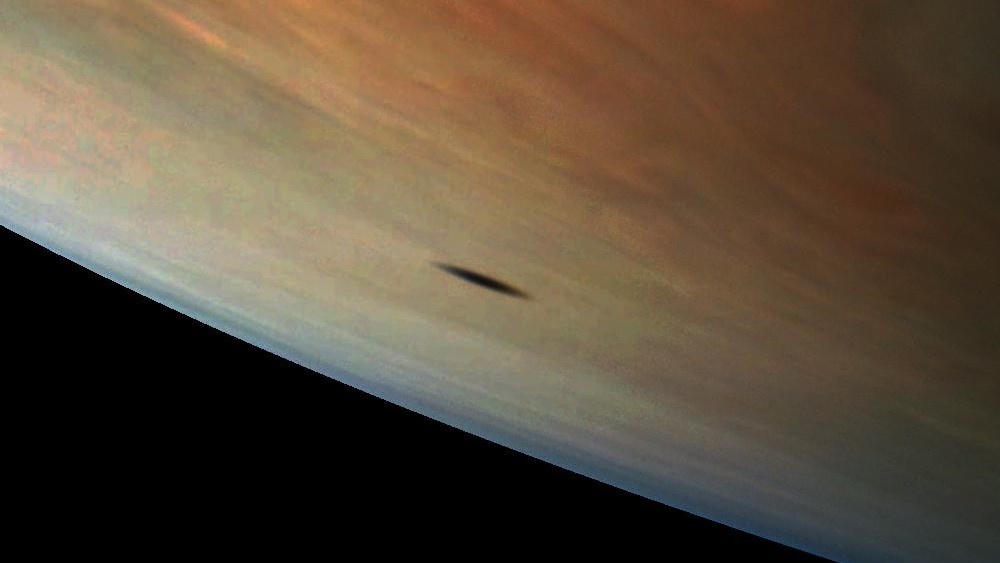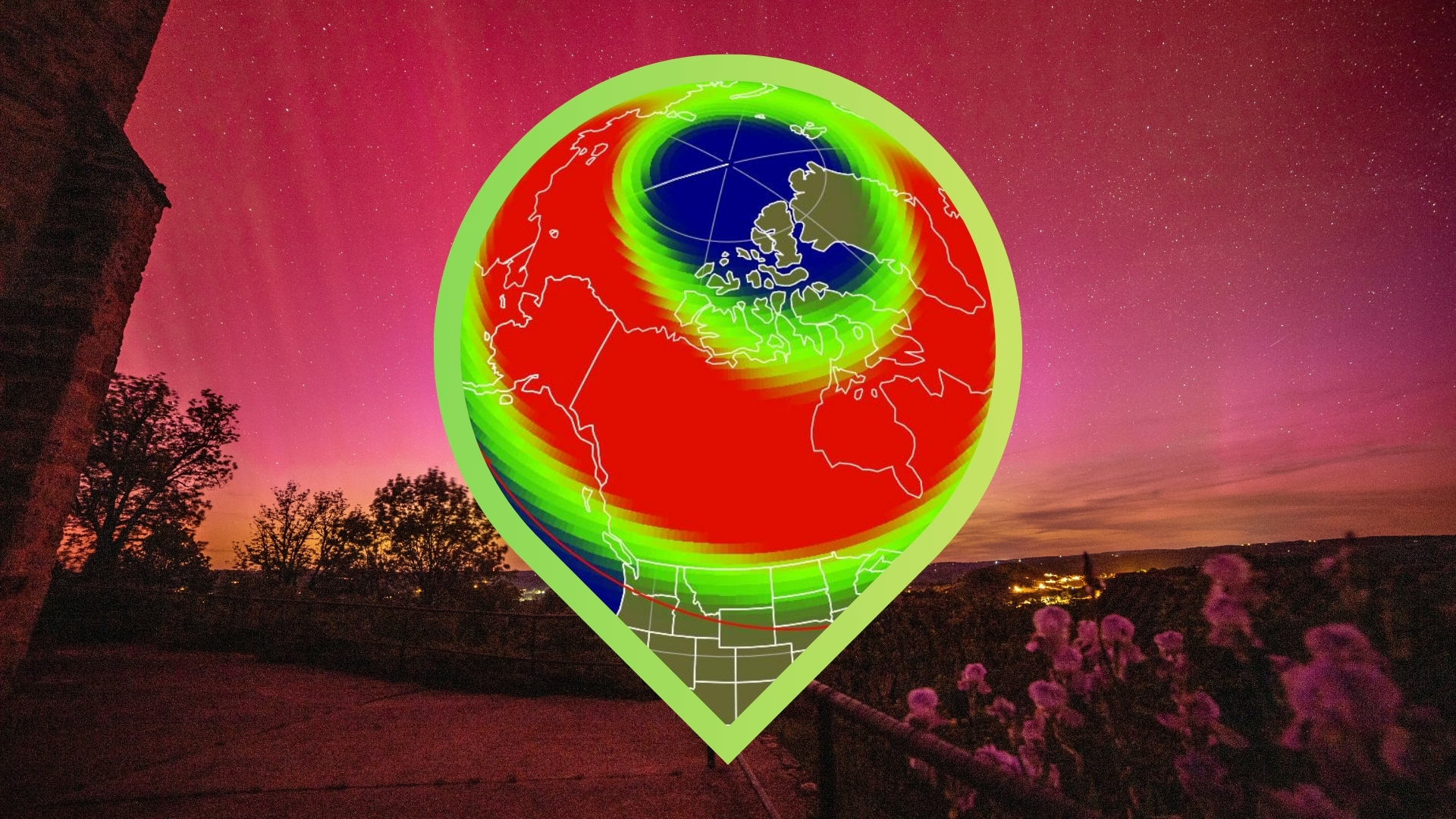Amalthea: Jupiter’s unusual inner moon
The mysterious, irregularly shaped Amalthea is one of Jupiter’s five inner moons.

The moon Amalthea is one of Jupiter’s 53 named satellites; it was the first to be discovered after the four Galilean moons, and it is the fifth-largest overall. In terms of proximity to Jupiter, Amalthea is the planet’s third moon — it takes just 12 hours to make a full orbit.
Shape: Irregular
Size: Mean radius of 51.88 miles (83.5 kilometers) ± 1.49 miles (2.4 kilometers)
Average distance from Jupiter: 112,717 miles (181,400 kilometers)
Orbit period: 11 hours, 54 minutes
Temperature: 155 ± 15 Kelvin
Composition: Rocky, specifics unknown
Astronomer Edward Emerson Barnard discovered Amalthea on September 9, 1892, while astronomer Camille Flammarion suggested the name Amalthea after the Greek mythological figure. Amalthea was the final planetary satellite in the solar system to be discovered by direct observation — that is, via a telescope rather than an imaging device like a satellite or a probe.
Not much is known about Amalthea, as it has only been observed by three spacecraft: Voyager 1 and Voyager 2 in 1979, and the Galileo spacecraft in 2002. While all three spacecraft took images of the moon, they are relatively low-quality. But what is known about Amalthea is that it is an irregularly shaped celestial body marked by large impact craters, hills, and valleys, and it contributes to Jupiter’s faint outer Gossamer Rings.
Related: Jupiter's Great Red Spot: Our solar system's most famous storm
What do we know about Amalthea?
Amalthea remains something of an enigma within the realm of Jupiter’s moons. Due to a lack of close observations, there are few things we know about Amalthea with certainty. We do know it is a potato-shaped, rocky body with a mean radius of 51.88 miles (83.5 kilometers) ± 1.49 miles (2.4 kilometers) according to NASA.
It orbits Jupiter at a distance of 112,717 miles (181,400 kilometers), taking 11 hours, 54 minutes to circle the planet — it is the third closest moon to Jupiter, belonging to the “inner moon” group alongside Metis, Adrastea, and Thebe. According to infrared photometry, Amalthea has a temperature of 155 Kelvin ± 15 Kelvin.
The discovery of Amalthea
Astronomer Edward Emerson Barnard is credited with the discovery of Amalthea; he observed the moon on September 9, 1892, via the Lick Observatory’s 36-inch refractory telescope in California.
Breaking space news, the latest updates on rocket launches, skywatching events and more!
Barnard originally named the moon Jupiter V — it was the fifth Jovian moon to be discovered, 282 years after Galileo first observed Io, Callisto, Europa, and Ganymede — collectively known as the Galilean moons.
Unsurprisingly, Amalthea is the fifth largest Jovian moon, making it relatively easy to spot compared to some of the smaller moons. But Amalthea is far smaller than the smallest of the Galilean moons, Europa, whose equatorial radius is nearly 17 times larger than Amalthea’s.
How Amalthea got its name
Astronomer Camille Flammarion suggested the name Amalthea after the Greek mythological figure. Amalthea is a naiad (water nymph) who nursed an infant Zeus (the Greek version of the god Jupiter) with goat milk in a cave in Crete. She is sometimes depicted as a goat.
Characteristics of Amalthea
Observations from the Galileo orbiter in the 1990s indicate that the moon has hills and valleys, and it is pockmarked by impact craters — according to Britannica. The largest is named Pan, and it has a diameter of 55 miles (90 kilometers), which is massive in relation to Amalthea’s size. It is the reddest object in our solar system; scientists believe that color may be due to sulfuric compounds from nearby Jovian moon Io, which is volcanically active.
Amalthea also contributes to one of the Gossamer Rings of Jupiter — the Amalthea Gossamer Ring — which is the faint innermost Gossamer ring of the planet. The Gossamer Rings are outside the main Jovian ring.
Mysteriously, Amalthea appears to radiate out more heat than it receives from the sun, which NASA suggests may be due to Jupiter’s magnetic field or from tidal stresses. Amalthea is tidally locked to Jupiter in synchronous rotation — it always aligns with the planet along its long axis.
Missions to Amalthea
Only two missions have visited Amalthea: Voyager and Galileo. Both the Voyager 1 and Voyager 2 spacecraft photographed the Jovian moon during their flybys in 1979. Then the Galileo spacecraft captured images of Amalthea at the turn of the 21st century with its Solid State Imaging (SSI) experiment, revealing more details about the unusual moon.
Galileo would have likely been able to provide even more data about Amalthea if its high-gain antenna had not malfunctioned. Because spacecraft had to transmit data back to Earth via its low-gain antenna, less information was returned from the mission.
The future of Amalthea
There are no future missions planned to Amalthea, though NASA does intend to send a probe to the Jovian moon Europa in 2024. NASA's Europa Clipper mission will observe Europa in great detail and investigate whether it exhibits life-harboring conditions, according to NASA Jet Propulsion Laboratory.
NASA predicts that Amalthea will eventually lose its orbit and crash into Jupiter.
Additional Resources
You can see photos of Amalthea taken by Voyager 1 in 1979 on NASA’s Voyager 1 Mission Page, and you can read about the spacecraft Galileo’s observations from its 2002 flyby on JPL’s Galileo site.
Bibliography
Joseph A. Burns et al. “Jupiter’s ring-moon system,” Jupiter. The planet, satellites and magnetosphere, 2004.
NASA, Solar System Science “Amalthea.”
Britannica, “Amalthea.”
P. C. Thomas et al. “The Small Inner Satellites of Jupiter,” Icarus, Volume 135, Issue 1, September 1998.

Space.com contributing writer Stefanie Waldek is a self-taught space nerd and aviation geek who is passionate about all things spaceflight and astronomy. With a background in travel and design journalism, as well as a Bachelor of Arts degree from New York University, she specializes in the budding space tourism industry and Earth-based astrotourism. In her free time, you can find her watching rocket launches or looking up at the stars, wondering what is out there. Learn more about her work at www.stefaniewaldek.com.


